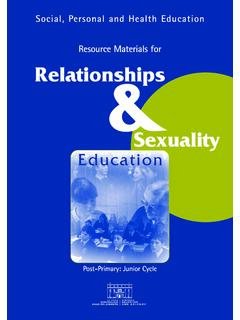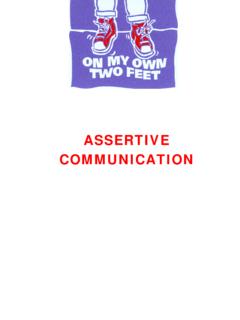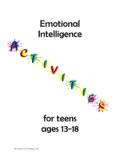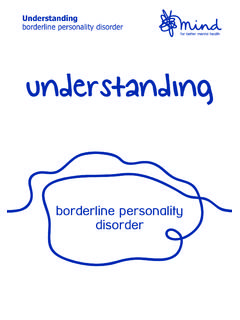Transcription of FEELINGS - SPHE
1 FEELINGS 2 FEELINGS This book is one of seven constituting On My Own Two Feet Educational Resource Materials for use in Substance Abuse Education Worksheets may be copied for educational purposes free and without special permission. Permission for additional use may be obtained from Dept. of Education and Science, Marlborough St., Dublin 1, Ireland An Roinn Oideachais agus Eola ochta, Department of Education and Science An Roinn Sl inte agus Leana , Department of Health and Children Mater Dei Counselling Centre ISBN No. 086387 044 9 2nd Edition 1997 3 CONTENTS INTRODUCTION 4 GRID OUTLINING MATERIALS 10 LESSON 1 HOW WOULD YOU FEEL?
2 14 LESSON 2 FEELING CARDS 18 LESSON 3 IDENTIFYING MY FEELINGS 21 LESSON 4 FEAR IN A HAT 24 LESSON 5 THE RELAXATION RESPONSE 26 LESSON 6 RELAXATION FOR ANXIETY 32 LESSON 7 UNDERSTANDING FEELINGS 35 LESSON 8 FEELINGS THERMOMETER 40 LESSON 9 EXPRESSING YOUR FEELINGS 44 LESSON 10 DEALING WITH ANGER 48 LESSON 11 SIDE-STEPPING ANGER 55 LESSON 12 CONSEQUENCES 58 LESSON 13 CHILDREN AND ALCOHOL 62 LESSON 14 LIZ 69 LESSON 15 TRANQUILLISERS: THE SEARCH FOR HAPPINESS 74 LESSON 16 WHAT SHOULD I DO? 80 4 INTRODUCTION HE ABILITY TO deal with our FEELINGS is essential to mental health and to positive interpersonal relationships. It is an area with which many people have great difficulty.
3 Drugs are often used as a prop in situations in which people are experiencing some anxiety, whether it is social anxiety due to low self esteem and poor social skills or, in more serious case, where a person may be using the drug to anaesthetise themselves from deeper emotional pain. An inability to express and deal with FEELINGS can lead to stress which, when experienced over a period of time, can lead to a variety of stress related illnesses or maladaptive coping mechanisms, as, for example in the excessive use of headache remedies or the reliance on alcohol to relax. Over forty physical and emotional disorders have been linked to stress. These include heart disease, high blood pressure, ulcers, headaches, back pain and depression.
4 Studies of cancer patients have also linked onset of cancer with a behaviour pattern characterised by denial and repression of anger and other negative emotions. In fact, the notion of negative emotions is a reflection of the value judgements we make on certain FEELINGS , , anger, grief, fear, while not on others love, joy, and happiness. The expression of emotions of fear, anger, grief and hurt is part of the healing process and is a prerequisite for healthy and happy living. We can pretend not to feel, but we still have FEELINGS anyway. However much we ignore, pretend or hide them away, FEELINGS will find their way out somehow.
5 For example, if we are hurt by someone, if we feel angry but don t do anything about it, we may find ourselves getting back at them in sneaky ways later we may gossip about them, tell stories and backbite . This is called leakage . Another way we handle unfinished FEELINGS is to push them down and hold them in physically. Holding FEELINGS in by stopping ourselves breathing properly and by tightening those muscles, which are involved, uses up energy and makes us tired. We suppress the body s natural mechanisms for releasing tension. It also uses up a lot of energy that could be used more productively. What exactly we do with our unexpressed FEELINGS is different for each one of us and is related to the messages we received growing up about what was acceptable or unacceptable.
6 The small child knows instinctively how to let go and finish with a situation. S/he cries, has a tantrum, clings to an adult or does whatever s/he needs to do to discharge the distress. This enables the child to move on with fresh vitality to the next experience. This same process is seen again and again in counselling or even in the everyday notion of have a good cry, it will make you feel better . Having got things T 5 off one s chest one is able to cope better, see things in perspective, sleep more deeply and work better. Small children are allowed to express their FEELINGS up a to certain point or age because they aren t expected to be able to control their FEELINGS .
7 However, they soon learn that many of their FEELINGS are not acceptable. Big boys don t cry or don t let them see you crying are common admonitions. While it is absolutely essential to be in control of how we express our FEELINGS (we can t just lash out at someone every time we re frustrated), in our society we go too far and we spend a lot of energy sitting on FEELINGS , holding in and pushing them down. We are frightened of strong FEELINGS . This is understandable in the case of anger, especially, if we have been at the receiving end of violent expressions of anger. However, anger is also a positive force it is an indication that something is wrong in the way we re being treated, it fires action for justice, it energises us to work for change.
8 It is possible to teach people how to express anger constructively, in a way which is respectful of the other person and which helps to resolve difficulties when they happen, thus preventing a build-up which leads to explosive outbursts, whether physical, verbal or against property. People are not for hitting should be a central message of the work. When others cry we often feel awkward and embarrassed. We don t know what to do or say. We may feel helpless, we may not be able to undo whatever has caused the tears and we wish we could. Just listening and being with the person doesn t seem enough, and giving them a hug or holding them close is something we d be embarrassed to do.
9 For men there is a particularly strong taboo on tenderness . Many men believe that to be manly, you shouldn t show any weak FEELINGS , so a strong man isn t supposed to cry, to feel hurt, to be scared, to need help, to feel lonely. Trying to be such a man is very lonely. You have to pretend not to be upset, you have to hide the real you. And eventually some men learn so well that they lose touch with themselves and do not feel anything much anymore. Another reason FEELINGS are neglected is that people are too busy. We don t have as much time for each other as we might have time to listen and so we get the message that our FEELINGS are not very important.
10 Instead of sharing our difficulties with friends and family, many people end up seeking counselling. We need to re-discover the potential for mutual support between people, the richness of real contact with others, the healing power of listening. 6 ISSUES TO CONSIDER BEFORE USING THE FEELINGS MATERIALS Because society does not encourage the expression of certain FEELINGS and, indeed, imposes such a strong taboo on those FEELINGS , a clear and calm approach to this section is very important. It should only be undertaken by teachers who are themselves at ease with, and comfortable with, the expression of FEELINGS . Attendance at workshops where teachers have the opportunity to deal with their own FEELINGS and to understand the importance of expressing them is the key to removing the fear, which some people experience in dealing with this area.











